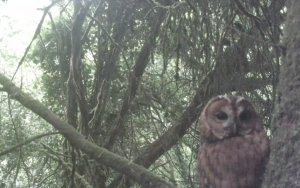 “Une chouette dans une épinette”.
“Une chouette dans une épinette”.
Sounds like an exotic title on a menu card!!!
But it means as much as:
“An owl in a spruce”
“Een uil in een spar”
Trailcameras have become immensely popular in just a few years time.
When I asked (on our book presentation) “who owns a trailcam?”, almost half the audience said they did!
To me, they are a great tool to use. Most of all, I like the unexpected visitor, or when I get to see interesting behaviour. Every time I collect one after being in the field for a while, it always feels like a little present when I get to see all the recordings.
 Here is a story of our holiday in Bretagne – France. I brought 2 trailcams along and placed them in 3 different spots. I used (as I do most of the time) the video option.
Here is a story of our holiday in Bretagne – France. I brought 2 trailcams along and placed them in 3 different spots. I used (as I do most of the time) the video option.
First location was a forest road where we found a lot off martenscat. Scat is something we humans can see, and it makes me aware of all the marking (urine, rubbing of glands) I cannot see!! And I know there is much more, I just watch my dog sniffing everywhere.
I collected some of those martenscats and placed them on top of the most fresh one.
Scats are interesting for a lot of animals, I am convinced they are checked by friends and foes!
At least an animal will stop for a little while, just to check, enough time for your camera to do it’s work.
We did find sign of badger (sniff hole, and just the one track) and a few roedeer tracks. So those were animals we were expecting to see on the videos. And yes, they did show up.
By taking a closer look at the antlers of these roedeer (all bucks by the way!) we discovered there were 3 bucks roaming the same area. Interesting behaviour!
A badger also showed up, as expected. He marked right at the spot with the little pile of martenscat. A hare also passed, new to us, as we didn’t find any other sign of them. He ignored the scat by the way.
 Plus, very regular: a fox! Almost every night it passed, and it always took the same route. And ‘it’ was a ‘she’: we knew, by looking at the way she marked – right on the martenscat.
Plus, very regular: a fox! Almost every night it passed, and it always took the same route. And ‘it’ was a ‘she’: we knew, by looking at the way she marked – right on the martenscat.
When checking the camera during the time I set it, I saw a lot of disturbance across the road. The side of the hollow road was demolished?! No tracks. We found the perpetrator on film: it was an escaped cow who had wrecked the bank with it’s feet and head! It gave a full display on film.
Surprisingly, there was not a single marten showing up on the videos?! We even spotted 2 pinemarten live at the end of several days, but none of them passed the camera so it seemed. At least, not without triggering the camera!
Don’t forget: the camera tries hard, but it still does not always registers everything passing!
By finding the scat (and in this case even seeing the animals live), we knew pine marten were around. Another important reason to always use a camera in combination with tracks and signs you find in the field. Don’t rely on just one.
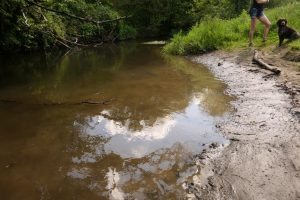
This bank was far more better to set the camera, but there was no way to hide it properly. Note the mud-smeared banks, ideal tracktrap!
Second location was on the bank of a small stream where we found quite a lot of tracks from nutria, and some otter. There was another wide bank nearby (see foto above), which offered more ‘catch’, as we found fox, duck, blackbird/song thrush, more nutria… and human! For me it was too tricky to leave my camera there, fully exposed, as there was no way of hiding it.
So, back to the smaller bank. I positioned my camera at ground level, and camouflaged it with grasses and mud (see foto above). I also smeared this bank with mud, to make a nice tracktrap which would register every single track.
When picking it up again a week later, I was happy to see clear otter tracks right in front of the camera, so I thought ‘kat in het bakkie’ as we say in Dutch.
But zapping through all the images… no otter. There was also a fresh human boot print in my track trap. No human on film either. Another example of setting a camera, finding tracks, but no results on video.
No catch at all is the best reason to move your camera, which I did.
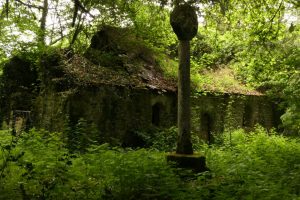 The third location was also a bit of an experiment to me.
The third location was also a bit of an experiment to me.
Close to where we stayed were the ruins of an old chapel. A mysterious place to say the least. Half of the roof had collapsed already and all kinds of greens had taken over the walls and roof.
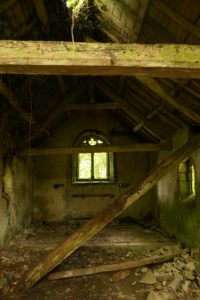
 With some effort I managed to climb into the chapel via one of the windows.
With some effort I managed to climb into the chapel via one of the windows.
White urine spots showed evidence of an owl who had chosen this place as a roosting spot.
In a few minutes I assembled a handful of feathers: tawny owl, for sure.
Plus a number of pellets too. There was no way of setting my camera in the chapel, sadly.
Close to the old church were a few spruce trees and they too were splashed with white urine marks.
It was easy to see at what height the owls would be sitting. Lots of branches made it very easy to climb the tree and I was lucky there was a vertical stem from a nearby tree to attach my camera to.
Time to wait, but there were only had 2 days left! ‘Nights’ is a better word, as I assumed the owls would choose this tree mainly at night or in the evenings, as it was quite an exposed place.
A few times I had sneaked around the ruin and when the owls were there, they were hiding either in the chapel, or in the yew trees, which provided them excellent cover with numerous branches. They never sat in the spruce trees.
And because the chapel was close to where we stayed, the alarm sounds of blackbirds and wrens told me the owls were discovered once again. The life of an owl…
 Two days later we left, so I had to collect the camera. I was ever so curious, so I couldn’t resist watching the footage up in the tree. Bingo! A tawny owl!!
Two days later we left, so I had to collect the camera. I was ever so curious, so I couldn’t resist watching the footage up in the tree. Bingo! A tawny owl!!
Here is just one video from a full hour of recordings.
The images are a bit blurry, but that is due to the fact that it’s late in the evening. And sadly: the owl’s feet can’t be seen, on close range I didn’t manage to aim the camera completely at the branch it was sitting on.
But still, enjoy watching this magnificent bird:
https://youtu.be/L-jIt-xv6nI

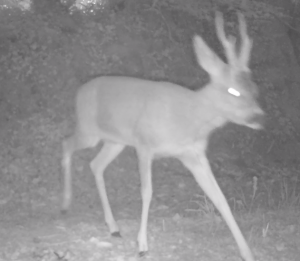

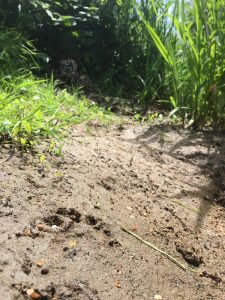
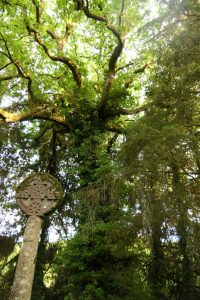

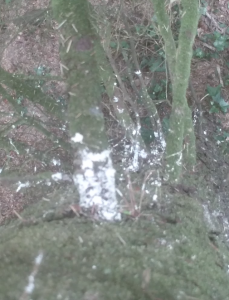

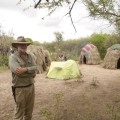

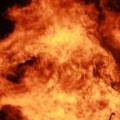
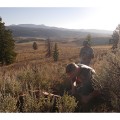


Geef een reactie